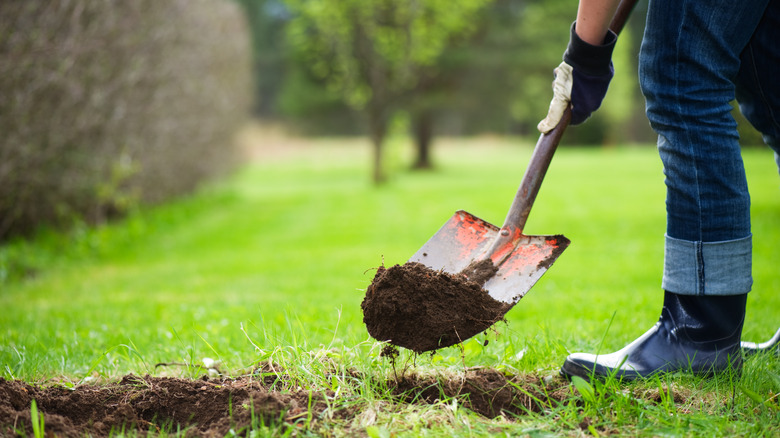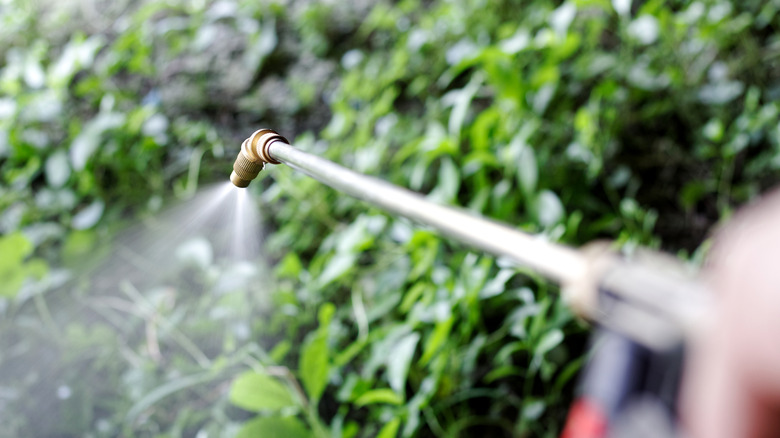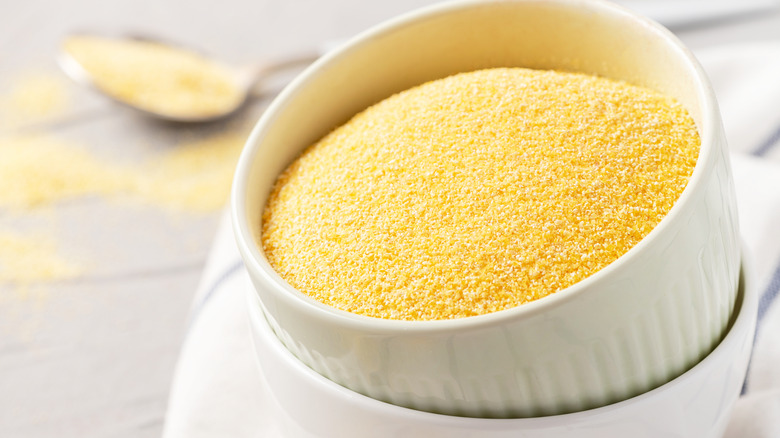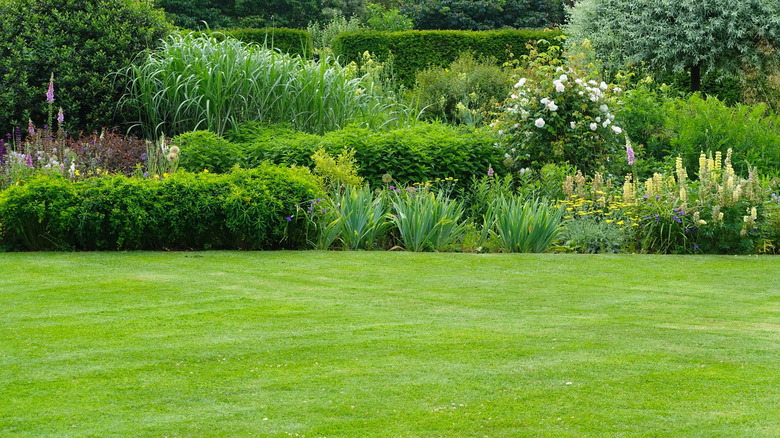Clover is a flowering perennial commonly found in lawns and yards throughout the United States, Europe, and Asia, according to Home and Garden Center Information. Some of the flowers bloom a soft white color with a purple tinge at the base while others are a purplish-pink hue, and have a lot of benefits for lawn and yard maintenance, including attracting pollinators and stimulating wild bee populations, increasing soil fertility, and eradicating other naturally growing weeds, says Earl May Garden Centers. They also look prettier than plain old grass.
Despite the benefits of the perennial, many don’t like the flowering plant growing in their yards. For one, it is not a good plant for people with lots of traffic in their yards — people with dogs, children, or who regularly walk through their yard will easily kill the flowers, resulting in a very awkward-looking yard. It can also become invasive in some areas, warns the United States Department of Agriculture, particularly in riparian or meadow zones and in the Southwest wildlands region of the country. Lastly, some people simply don’t like the look of clover in their yards. To learn how to get rid of clover in your lawn, keep reading.
Dig it up

One of the easiest and most obvious ways to get rid of clover in your yard is to simply pull it up. This method is most effective with smaller, contained patches of clover, advises Lawn Love, as you need to be careful to remove all the roots. Otherwise, your efforts will have been useless, and the white flowers will soon reappear in your yard.
Using a garden spade, loosen up the soil around the clover patch enough to be able to thoroughly dig it out. Then, using a weeding tool or your hands (make sure to wear gloves!), uproot the clover. Pull firmly at the base to better help get all the roots out in one go. Inspect the soil, and make sure there aren’t any roots left. This is a great, easy, and cheap way to remove clover from your lawn, and as a bonus, it won’t kill any surrounding grass.
Suffocate the plant
This next method may seem a little medieval, but it’s effective. According to This Old House, another quick and easy way to kill clover in your yard is to essentially suffocate it. This method is best for people who have large, stubborn patches of clover in their yard, as it will most certainly kill the surrounding grass. That being said, it doesn’t involve any harsh chemicals, so it should grow back soon enough.
Since clover is a living plant, you can kill it by depriving it of all sun and oxygen. To do this, get a plastic garden tarp, cut up the trash bag or similar material, and cut it to the size of your clover patch. Then, using rocks, bricks, or another heavy object, weigh down the corners and edges of the tarp, making sure as little oxygen as possible can get in. Consider adding weights in the center for extra security. The clover should be dead in a few weeks.
Introduce a nitrogen-heavy fertilizer
The Toidi/Shutterstock
Clover often grows in yards with low nitrogen, says Bob Vila, as the flowering perennial naturally creates its own surplus. This is one way that clover can be beneficial to lawns, as it adds extra nutrients to the grass and yard, creating a stronger, healthier lawn. However, if you don’t want clover patches, the low nitrogen content can make it hard to both prevent and eliminate the plant.
This can be combated by simply introducing extra nitrogen into your yard. Many landscapers will recommend feeding your lawn anyways to strengthen the grass and fight against multiple types of weeds, but a weed and feed with high nitrogen content can help specifically combat clover growth. While organic, slow-release fertilizers will certainly work, they can be a little slow in the face of fast-growing clover and not as potent. A standard, quick-acting fertilizer will be best. Alternatively, Lawn Love recommends fertilizer like bone or blood meal, liquid kelp, and manures like cow manure, guano, or earthworm castings.
Mow on a higher level
Roman Zaiets/Shutterstock
Since clover grows so low to the ground and condensed, it makes sense that your first impulse may be to lower your mowing height in an attempt to kill off the flowering plant. A low mow height won’t actually do anything to eliminate clover, though, according to Scotts. Removing the flower heads won’t do anything to disrupt the clover’s growth, as it needs to be completely uprooted or killed off by either natural or chemical methods.
While it may feel counterintuitive, the best way to get rid of clover when mowing is to raise the blade height. As covered earlier, an effective way to kill clover is to deprive it of sunlight. This can be done through a little lawn manipulation, like letting your grass grow taller than the flowering perennial and block out the sunlight needed to keep growing. While this likely won’t eliminate clover patches, it will help contain spreading as you work through other methods.
Create a vinegar solution
FotoHelin/Shutterstock
There are plenty of solutions to kill clover, both chemical and natural, which will be covered shortly. That being said, it is quite easy to make your own natural clover killing mixture. This way, you can know exactly what you’re exposing your lawn to. It’s also cheaper than most commercial weed sprays, whether organic or synthetic.
To make your own clover spray, Lawn Love says you will need water, dish soap, vinegar, and a spray bottle. How much you make will depend on the amount of clover you have in your yard, but a starting ratio is 1 cup vinegar, 1 cup water, and 1 drop of dish soap. Simply combine the ingredients in a spray bottle, shake vigorously, and apply generously to clover patches. The vinegar dries out the plant and kills it, and the dish soap helps the vinegar cling to the flowers and leaves. That being said, be careful not to accidentally get any of the spray on grass, as it will do the same to it. Apply frequently as needed for a few weeks, and then fill in the bald spots with grass seed once all the clover is dead.
Apply herbicides

Kritchai7752/Shutterstock
A more intense solution to getting rid of clover in your lawn is applying a broadleaf herbicide, recommends Bob Vila. Broadleaf herbicides come in a variety of options, and you should be careful when choosing one for your yard. For targeting a specific weed, you should look for a selective herbicide, advises The Yard and Garden. Non-selective herbicides, while effective, will kill anything it’s applied to, including your lawn. Selective herbicides, on the other hand, are formulated to kill off particular weeds while maintaining the integrity of your yard.
Bob Vila specifically recommends a selective herbicide with dichlorophenoxyacetic acid, mecoprop, and dicamba, which will wither and kill all weeds, not just clover. A popular option for clover is A.D.I.O.S. There are a few drawbacks to this option to keep in mind, though. For one, many herbicides, selective or not, are toxic to pets and wildlife. This is also a much more expensive option, with one 36-ounce bottle costing up to $37.
Use corn gluten

Svetlana Monyakova/Shutterstock
A great, natural, and chemical-free way to remove clover from your yard is through the application of corn gluten, according to This Old House. Corn gluten is commonly used for adding extra nutrients in hog food, per The Spruce, and is considered a natural, pre-emergent herbicide. It is most popular in the control of crabgrass but is effective for clover prevention, too. When corn gluten is applied to your lawn, it prevents germinated seeds from developing roots. It also has a 10% nitrogen content, which is great for adding a little extra nitrogen to your garden to prevent further clover growth.
Lawn Love recommends applying 20 pounds of corn gluten to every 1,000 square feet of lawn space. Simply sprinkle throughout your yard, water, and let dry. Be careful, though, as corn gluten, while not harmful to existing grass, prevents any seeds from rooting, including grass seed. Corn gluten is commonly found at garden supply stores or from online sellers.
Preventive measures

1000 Words/Shutterstock
Now that you know how to get rid of clover in your lawn, you should learn how to prevent it from coming back to save yourself the hassle of removing it again. Clover is a perennial, after all, so it has every possibility of popping back up the next season. There are a handful of reasons clover grows in lawns. Something as simple as overwatered grass, for example, can encourage clover growth, according to Bob Vila. Lawns also benefit from the added nutrients of the flowering plant, so an abundance of clover isn’t a failure on your part.
There are things to look out for to prevent further growth, though. As we’ve already covered, a lawn low in nitrogen will definitely invite the nitrogen-rich perennial to come help supplement it. Compacted soil is also something that attracts clover, says Lawn Love, as it doesn’t facilitate grass growth, but clover can handle the difficult conditions. This can be fixed by aerating your soil. Lastly, an off-balance pH can invite clover growth, according to This Old House. Most lawns prefer to be between 6.0 and 7.0. If your pH is below that number, it’s too acidic for grass to grow but not for clover. Adding lime and other alkaline soil amendments can help combat this.


